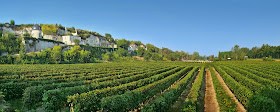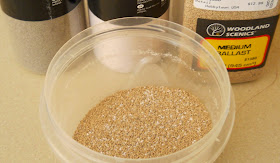Vineyards make excellent, useful terrain features in all kinds of different games. They limit maneuverability, provide concealment for infantry, and nicely fill table space. For WW2 gaming, they can be included in nearly every theater in which the war was fought. Wine-producing regions include NW Europe, Belorussia, Italy, Greece and the Balkans, Crete, the Levant, and even French Morocco and Syria.
I'll be honest, I've always wanted to make vineyards but have been rather daunted by getting it "just right" - the perfect balance between playability and realism. While the Battlefront FOW version is nice, it's rather clunky. Well, I finally threw caution to the wind and tried my hand at it....and now I wonder why I waited so long. Really the only problem was the "fiddliness" of affixing the wire trellising to the end posts, but I'll show you how to tackle that problem.
Materials
- Wide popsicle sticks ("tongue depressers")
- Toothpicks
- Dry, thin tree branch shoots
- Medium Ballast in various colors OR sand
- Thin gauge metal wire OR black upholstery thread
- Foliage-Fiber Clusters OR Clump Foliage
- Felt
- Static grass (optional)
- White, wood, & CA glues
- X-acto knife and/or utility knife
- Black primer
- Clear flat spray sealant
- Dirt-tone acrylic colors
1. Using a knife, cut the spiky ends off a series of wood toothpicks. Then, cut each toothpick into thirds -measurements don't have to be exact. Glue one section of toothpick on to the end of each popsicle stick, leaving about 1/2" of space at the end for the post supports. I used CA glue for this step.
2. Using a cutting mat grid or the corner of a piece of scrap paper, line toothpicks on a 45 degree angle, cut off the ends along the grid lines (or paper edges if using paper). Each piece should resemble the picture below once cut. Once cut, glue these post supports between each end post and the popsicle sticks. This will provide additional support and stability when tying the the wire trellises.
3. The trickiest part! Using thin gauge wire or black upholstery thread, cut a piece about 2.5x the length of the popsicle stick. Begin by winding the wire around one end post below the post support, use a drop of CA glue to secure it once wound.
4. Keeping the wire tight, wind it around the opposite end post, below the post support. Use a drop of CA glue to secure it. Then, wind the wire up around the post over the post support, as picture below. Keeping the wire tight, wind it around the first post above the post support. Use CA glue to secure it, then clip the excess.
5. You should now have two wire trellises one atop the other, running between each end post. Do this for the rest of the sticks. Don't worry if it seems fragile - reinforcement will come when you add the vine trunks.
6. Spray all the sticks with black primer and let dry.
7. Take a couple dry, thin tree branch shoots from your yard and cut off pieces just about the height of the top wire trellis on each stick. Glue several in a row alongside the wire trellising on each base using wood glue. Don't worry about painting them - they're already the perfect color!
8. Once dry, paint each end post a greyish-brown color to resemble weathered wood. Try to avoid painting the wire trellising. Let thoroughly dry.
9. Mix various colors of medium railroad ballast to resemble the harsh, often rocky soil grapevines thrive in. I'm using grey, white, and buff colored ballast. Spread wood or white glue evenly over each base, then sprinkle liberally with ballast. Allow to thoroughly dry before shaking off the excess ballast.
10. Once the ballast is dry, mix your preferred earth toned acrylic colors. I use a base of medium grey, mixed with equal parts medium brown and biege, with a small drop of dark red. Dip your brush in water to dilute the paint into a heavy wash and apply to the base. The wash should soak into the crevices between the stones and just slightly tinge the stones themselves, helping to blend them together.
11. Allow to dry, then seal well with flat spray sealant.
12. Pull long thick strands of fiber-foliage apart. Place drops of white glue on the top of each vine trunk, then a long line on the underside of the foliage strand. Place down along the top of the trellising and vine trunks. Try to fold the foliage over each side and push together. If you want, once the foliage is dry, apply static grass to the base. Just don't use too much - a good vintner wouldn't want grass stealing the nutrients from the soil that the grapes could use!
13. Cut enough pieces of felt fabric to accommodate your bases. I've cut three pieces, large enough to fit four bases in single rows, with enough room in between to accommodate a medium FOW base. I used beige felt, then did a light overspray of grey and brown with spray paint.
That's it - you're done! Though I made these vineyards for 15mm, if you cut the end posts a little higher and added a third wire trellis - these could easily be used for 28mm gaming. If you cut the end posts down a bit and only used one wire trellis, these could even be made for 6mm!















Really nice terrain - very effective.
ReplyDeleteThis comment has been removed by the author.
ReplyDeleteThose came out really, really nice! Thanks for the post. I've been considering making some agricultural scenery lately, and this is an excellent basis from which to start.
ReplyDeleteA great "how to". Good job
ReplyDelete